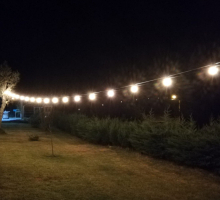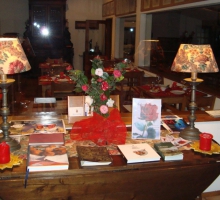The Route of the Viewpoints covers most of the county, through the most emblematic places of the natural heritage, as exemplified by the "Senhora da Graça" and the Water Falls of Fisgas of Ermelo. It is a valuable route by offering panoramic perspectives at every point. Along the way you can observe different types of landscape with plateaus, deep valleys and steep reliefs. Through the Natural Park of Alvão, you can find villages with rich rural architecture and observe the people in their day-to-day. This route will delight the lovers of photography.
Route type: By car / Circular
Point: Tourist Office
Arrival point: Mondim de Basto
Length: 92.32 km
Duration: 4 hours
Difficulty: Medium
Support: Picnic Parks: Nossa Senhora da Graça; Fisgas of Ermelo (Fojo).
Points of interest: Shrine of Our Lady of Mercy; Shrine of Our Lady of Grace (41º 24 '59.01' 'N, 7 54' 56.35 '' W); Castro's Crastoeiro (41º 24 '53.21' 'N, 7 55' 46.13 '' W); Water Falls Bilhó; Water Falls of Fisgas of Ermelo; Ermelo village; Rio Olo.
1. Nossa Senhora da Graça Viewpoint
Location – Senhora da Graça summit
Parish – Vilar de Ferreiros
Access route – EM 312;
Altitude – 996m;
GPS coordinates - 41º 24’ 59’’ N 7º 54’ 57’’ W
The Senhora da Graça viewpoint is one of the most imposing in the region. From here, you may enjoy such unforgettable panoramic views as the Alvão, Marão and Cabreira mountain ranges and the valley of the River Tâmega, which divides the regions of Minho and Trás-os-Montes.
Facing west at the foot of the mountain and overlooking the village of Campos, it’s possible to view the fortified settlement of the Castroeiro with its circular stone buildings, typical of the Iron Age in the northwest. Little more than 200m north, a massive rock is hidden amongst the trees, adorned with mostly geometric motifs. It was the centre of the pre-historic Campelo sanctuary, a sacred place for the pre and proto historical peoples who inhabited the region.
2.Nossa Senhora da Piedade Viewpoint
Location – Nossa Senhora da Piedade Mount
Parish – São Cristóvão de Mondim de Basto
Access route – EN304;
Altitude – 250m;
GPS coordinates - 41º 24’ 26’’ N 7º 57’ 41’’ W
Looking about us, towards the sunrise, lies the backdrop of the Nossa Senhora da Graça chapel crowning Monte Farinha. A little closer we can see the historic Tâmega-Line railway bridge, now a cycle and pedestrian path, along with the warm and welcoming town of Mondim de Basto.
On the opposite side lies the river Tâmega, fed by waters carried by the Cabril all the way from the Alvão plateau. Here, where the riverbed widens, the water catches the rays of the setting sun, providing a landscape of rare beauty.
3. Paradança Viewpoint
Location – ER 304
Parish – Convergence of the Parishes of Campanhó and Paradança;
Access route – EN304;
Altitude – 335m;
GPS coordinates - 41º 23’ 02’’ N 7º 56’ 44’’ W
In the distance you can see the Cabreira peaks and the cone-shaped mountain of Senhora da Graça, providing a backdrop for Mondim de Basto, the district’s most urbanised area. We have the advantage of being able to enjoy its green fields, which at the same time are interlaced with human activity. In the foreground, Vilar de Viando’s vineyards remind us of the fact that this is a region of ancient wine production, as evidenced by the three wine presses dug into rock, which may be found on the hillsides and which may date back to the Roman period.
4. Barreiro Viewpoint
Location – Barreiro
Parish –Convergence of the Parishes ofErmelo and Pardelhas;
Access route – ER304; EM 1204;
Altitude – 923m;
GPS coordinates - 41º 21’ 15’’ N 7º 50’ 61’’ W
Deep into the Alvão Natural Park’s mountainous area, the village of Barreiro is a small cluster of granite houses, some of which still have thatched roofs. The main activities are agriculture and the rearing of livestock. At its centre, an interesting steeple stands out, separated from the church building.
Monte Farinha, with the Nossa Senhora da Graça chapel, is a constant view throughout practically all the district. From this point, however, it takes on a particular form, at the end of a chain of ridges descending from the Alvão which also include the Palhaço and Palhacinhos hills. Between these two lies the mythical Mina dos Mouros, (The Moors’ Spring), where horses were taken to drink from the River Tâmega, a legend common in many places where there are archaeological ruins, such as the Palhacinhos.
Also worth noting is the traditional architecture of some of the villages, with their own rustic design and interesting aspects in terms of sociology, craftwork, and landscape. Fervença may also be seen, with its beautifully rich, green, terraced farmland.
5. Pardelhas Viewpoint
Location – By the bus stop, entering Pardelhas
Parish –Convergence of the Parishes of Ermelo and Pardelhas;
Access route – ER304;
Altitude – 720m;
GPS coordinates - 41º 20’ 11’’ N 7º 52’ 07’’ W
In a 180° radius the landscape assumes different scenic characteristics, all of them special. Straight ahead we can see the Alvão hillside, stripped of vegetation, and bearing the marks of human occupation which legend claims was a refuge for the population of Ermelo during an epidemic. The River Sião runs from South to North through a narrow valley overlooked by the Malhada Pequena apiary wall, which reminds us that in this area walls were made which used to shield beehives from the bears that inhabited the mountain. Turning south we see the Trigo spring, with crystal clear water ready to quench the thirst of those who pass by, followed by the quartzite crests descending from the heights of Vaqueiro, blocking the way through to this wild wonderland.
6. Alto do Velão Viewpoint
Location – Entrance into Campanhó via Alto do Velão
Parish –Convergence of the Parishes ofErmelo and Pardelhas;
Access route – ER304;
Altitude – 960m;
GPS coordinates - 41º 19’ 06’’ N 7º 53’ 19’’ W
On the horizon, between Alvão and Cabreira lie the old Basto lands. In the foreground are Pardelhas and Ermelo a more arid, schist area, used mostly for livestock and rye cultivation, with patches of pine woods, providing wood and resin. Beyond that, we can see Paradança and the river Tâmega, and the regions of Cabeceiras and Celorico. From there onwards the Minho region’s lush green, with its corn fields and vineyards, replaces the Transmontano landscape.
7. Campanhó Viewpoint
Location – Turn off for Campanhó (Tejão/Campanhó road)
Parish –Convergence of the Parishes ofCampanhó and Paradança;
Access route – E.M. 1205;
Altitude – 675m;
GPS coordinates - 41º 19’ 36, 21’’ N 7º 55’ 32,66’’ W
From here we see countless rocky hills where wolves spy on the herds of goats grazing on the undergrowth. Blending in with the hillside’s landscape, small mountain villages overlook fields, which are always kept lush by the abundance of water. Built closely together from local schist and with slate roofs, these simple houses have two levels with few openings, thus preventing the entrance of cold draughts or the escape of the heat produced by hearths always kept alight and the warmth of the animals kept on the lower level.
8. Fisgas de Ermelo Viewpoint
Location – Fisgas de Ermelo
Parish – Convergence of the Parishes of Ermelo and Pardelhas
Access route – E.N. 304 / C.M. 1200
Altitude – 600m;
GPS coordinates - 41º22`33.44``N7º52`10.55``W
A window into the Earth’s distant past, Fisgas de Ermelo’s quartzite rocks rise up into a unique, breath-taking, vertiginous landscape. Writer and poet Miguel Torga described it as a ‘mixture of wonder and terror’.
These quartzite rocks were initially the sands in a shallow sea by the beaches of the ancient Gondwana continent, near the South Pole about 500 million years ago.
Since that distant time, the sands became hard rocks, the beaches rose up to form mountains and eventually drifted to the northern hemisphere. Meanwhile, all the ancient continents came together in a truly titanic collision, forming the supercontinent Pangeia. This series of adventures which our planet has lived through can be read at the Fisgas de Ermelo, where the rocks pile up into a magnificent crag, a real bookof stone that safeguards these impressive, long ago stories.
The waters of the River Olo give life to the Alvão Natural Park, bathing its villages, its fields.
Where it passes it offers freshness and greenness, then it crashes down, lofty and magnificent, into what are considered by many to be one of the greatest waterfalls of Portugal – The Fisgas of Ermelo.
Location: Mondim de Basto
Route type: By car / Circular
Point: Tourist Office
Arrival point: Mondim de Basto
Length: 92.32 km
Duration: 4 hours
Difficulty: Medium
Support: Picnic Parks: Nossa Senhora da Graça; Fisgas of Ermelo (Fojo).
Points of interest: Shrine of Our Lady of Mercy; Shrine of Our Lady of Grace (41º 24 '59.01' 'N, 7 54' 56.35 '' W); Castro's Crastoeiro (41º 24 '53.21' 'N, 7 55' 46.13 '' W); Water Falls Bilhó; Water Falls of Fisgas of Ermelo; Ermelo village; Rio Olo.
1. Nossa Senhora da Graça Viewpoint
Location – Senhora da Graça summit
Parish – Vilar de Ferreiros
Access route – EM 312;
Altitude – 996m;
GPS coordinates - 41º 24’ 59’’ N 7º 54’ 57’’ W
The Senhora da Graça viewpoint is one of the most imposing in the region. From here, you may enjoy such unforgettable panoramic views as the Alvão, Marão and Cabreira mountain ranges and the valley of the River Tâmega, which divides the regions of Minho and Trás-os-Montes.
Facing west at the foot of the mountain and overlooking the village of Campos, it’s possible to view the fortified settlement of the Castroeiro with its circular stone buildings, typical of the Iron Age in the northwest. Little more than 200m north, a massive rock is hidden amongst the trees, adorned with mostly geometric motifs. It was the centre of the pre-historic Campelo sanctuary, a sacred place for the pre and proto historical peoples who inhabited the region.
2.Nossa Senhora da Piedade Viewpoint
Location – Nossa Senhora da Piedade Mount
Parish – São Cristóvão de Mondim de Basto
Access route – EN304;
Altitude – 250m;
GPS coordinates - 41º 24’ 26’’ N 7º 57’ 41’’ W
Looking about us, towards the sunrise, lies the backdrop of the Nossa Senhora da Graça chapel crowning Monte Farinha. A little closer we can see the historic Tâmega-Line railway bridge, now a cycle and pedestrian path, along with the warm and welcoming town of Mondim de Basto.
On the opposite side lies the river Tâmega, fed by waters carried by the Cabril all the way from the Alvão plateau. Here, where the riverbed widens, the water catches the rays of the setting sun, providing a landscape of rare beauty.
3. Paradança Viewpoint
Location – ER 304
Parish – Convergence of the Parishes of Campanhó and Paradança;
Access route – EN304;
Altitude – 335m;
GPS coordinates - 41º 23’ 02’’ N 7º 56’ 44’’ W
In the distance you can see the Cabreira peaks and the cone-shaped mountain of Senhora da Graça, providing a backdrop for Mondim de Basto, the district’s most urbanised area. We have the advantage of being able to enjoy its green fields, which at the same time are interlaced with human activity. In the foreground, Vilar de Viando’s vineyards remind us of the fact that this is a region of ancient wine production, as evidenced by the three wine presses dug into rock, which may be found on the hillsides and which may date back to the Roman period.
4. Barreiro Viewpoint
Location – Barreiro
Parish –Convergence of the Parishes ofErmelo and Pardelhas;
Access route – ER304; EM 1204;
Altitude – 923m;
GPS coordinates - 41º 21’ 15’’ N 7º 50’ 61’’ W
Deep into the Alvão Natural Park’s mountainous area, the village of Barreiro is a small cluster of granite houses, some of which still have thatched roofs. The main activities are agriculture and the rearing of livestock. At its centre, an interesting steeple stands out, separated from the church building.
Monte Farinha, with the Nossa Senhora da Graça chapel, is a constant view throughout practically all the district. From this point, however, it takes on a particular form, at the end of a chain of ridges descending from the Alvão which also include the Palhaço and Palhacinhos hills. Between these two lies the mythical Mina dos Mouros, (The Moors’ Spring), where horses were taken to drink from the River Tâmega, a legend common in many places where there are archaeological ruins, such as the Palhacinhos.
Also worth noting is the traditional architecture of some of the villages, with their own rustic design and interesting aspects in terms of sociology, craftwork, and landscape. Fervença may also be seen, with its beautifully rich, green, terraced farmland.
5. Pardelhas Viewpoint
Location – By the bus stop, entering Pardelhas
Parish –Convergence of the Parishes of Ermelo and Pardelhas;
Access route – ER304;
Altitude – 720m;
GPS coordinates - 41º 20’ 11’’ N 7º 52’ 07’’ W
In a 180° radius the landscape assumes different scenic characteristics, all of them special. Straight ahead we can see the Alvão hillside, stripped of vegetation, and bearing the marks of human occupation which legend claims was a refuge for the population of Ermelo during an epidemic. The River Sião runs from South to North through a narrow valley overlooked by the Malhada Pequena apiary wall, which reminds us that in this area walls were made which used to shield beehives from the bears that inhabited the mountain. Turning south we see the Trigo spring, with crystal clear water ready to quench the thirst of those who pass by, followed by the quartzite crests descending from the heights of Vaqueiro, blocking the way through to this wild wonderland.
6. Alto do Velão Viewpoint
Location – Entrance into Campanhó via Alto do Velão
Parish –Convergence of the Parishes ofErmelo and Pardelhas;
Access route – ER304;
Altitude – 960m;
GPS coordinates - 41º 19’ 06’’ N 7º 53’ 19’’ W
On the horizon, between Alvão and Cabreira lie the old Basto lands. In the foreground are Pardelhas and Ermelo a more arid, schist area, used mostly for livestock and rye cultivation, with patches of pine woods, providing wood and resin. Beyond that, we can see Paradança and the river Tâmega, and the regions of Cabeceiras and Celorico. From there onwards the Minho region’s lush green, with its corn fields and vineyards, replaces the Transmontano landscape.
7. Campanhó Viewpoint
Location – Turn off for Campanhó (Tejão/Campanhó road)
Parish –Convergence of the Parishes ofCampanhó and Paradança;
Access route – E.M. 1205;
Altitude – 675m;
GPS coordinates - 41º 19’ 36, 21’’ N 7º 55’ 32,66’’ W
From here we see countless rocky hills where wolves spy on the herds of goats grazing on the undergrowth. Blending in with the hillside’s landscape, small mountain villages overlook fields, which are always kept lush by the abundance of water. Built closely together from local schist and with slate roofs, these simple houses have two levels with few openings, thus preventing the entrance of cold draughts or the escape of the heat produced by hearths always kept alight and the warmth of the animals kept on the lower level.
8. Fisgas de Ermelo Viewpoint
Location – Fisgas de Ermelo
Parish – Convergence of the Parishes of Ermelo and Pardelhas
Access route – E.N. 304 / C.M. 1200
Altitude – 600m;
GPS coordinates - 41º22`33.44``N7º52`10.55``W
A window into the Earth’s distant past, Fisgas de Ermelo’s quartzite rocks rise up into a unique, breath-taking, vertiginous landscape. Writer and poet Miguel Torga described it as a ‘mixture of wonder and terror’.
These quartzite rocks were initially the sands in a shallow sea by the beaches of the ancient Gondwana continent, near the South Pole about 500 million years ago.
Since that distant time, the sands became hard rocks, the beaches rose up to form mountains and eventually drifted to the northern hemisphere. Meanwhile, all the ancient continents came together in a truly titanic collision, forming the supercontinent Pangeia. This series of adventures which our planet has lived through can be read at the Fisgas de Ermelo, where the rocks pile up into a magnificent crag, a real bookof stone that safeguards these impressive, long ago stories.
The waters of the River Olo give life to the Alvão Natural Park, bathing its villages, its fields.
Where it passes it offers freshness and greenness, then it crashes down, lofty and magnificent, into what are considered by many to be one of the greatest waterfalls of Portugal – The Fisgas of Ermelo.
Location: Mondim de Basto









